1998 CADILLAC ELDORADO light
[x] Cancel search: lightPage 123 of 380
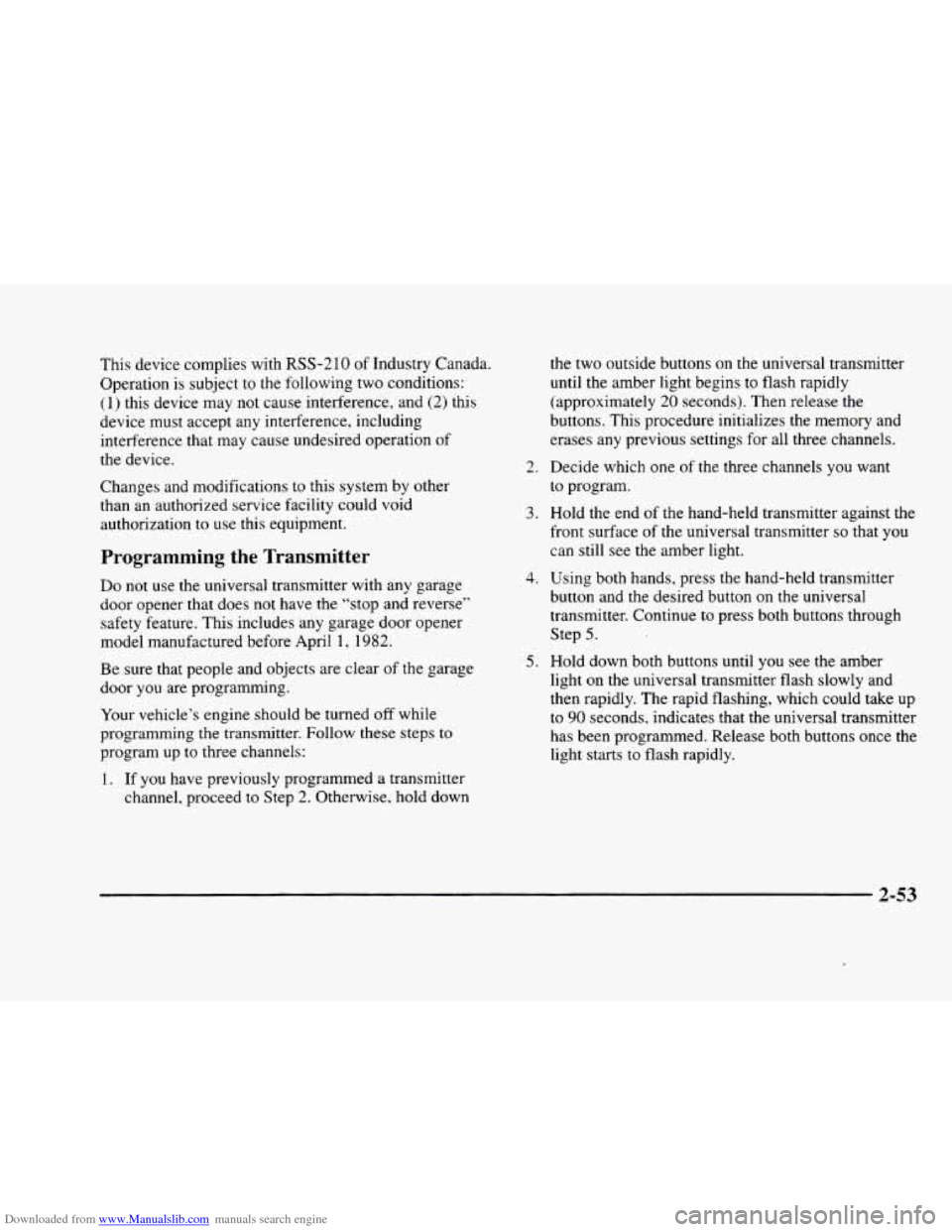
Downloaded from www.Manualslib.com manuals search engine This device complies with RSS-210 of Industry Canada.
Operation is subject to the following two conditions:
(1 j this device may not cause interference, and (2) this
device must accept any interference, including
interference that may cause undesired operation
of
the device.
Changes and modifications to this system by other
than an authorized service facility could void
authorization
to use this equipment.
Programming the Transmitter
Do not use the universal transmitter with any garage
door opener that does not have the “stop and reverse”
safety feature. This includes any garage door opener
model manufactured before April
1, 1982.
Be sure that people and objects are clear of the garage
door you are programming.
Your vehicle’s engine should be turned
off while
programming the transmitter. Follow these steps
to
program up to three channels:
1. If you have previously programmed a transmitter
channel, proceed to Step
2. Otherwise, hold down the
two outside buttons on
the universal transmitter
until the amber light begins to flash rapidly
(approximately
20 seconds). Then release the
buttons. This procedure initializes the memory and
erases any previous settings for all three channels.
2. Decide which one of the three channels you want
to program.
3. Hold the end of the hand-held transmitter against the
front surface of the universal transmitter
so that you
can still see the amber light.
4. Using both hands, press the hand-held transmitter
button and the desired button on the universal
transmitter. Continue
to press both buttons through
Step
5.
light on the universal transmitter flash slowly and
then rapidly. The rapid flashing, which could take up
to
90 seconds, indicates that the universal transmitter
has been programmed. Release both buttons once the
light starts
to flash rapidly.
5. Hold down both buttons until you see the amber
2-53
Page 124 of 380
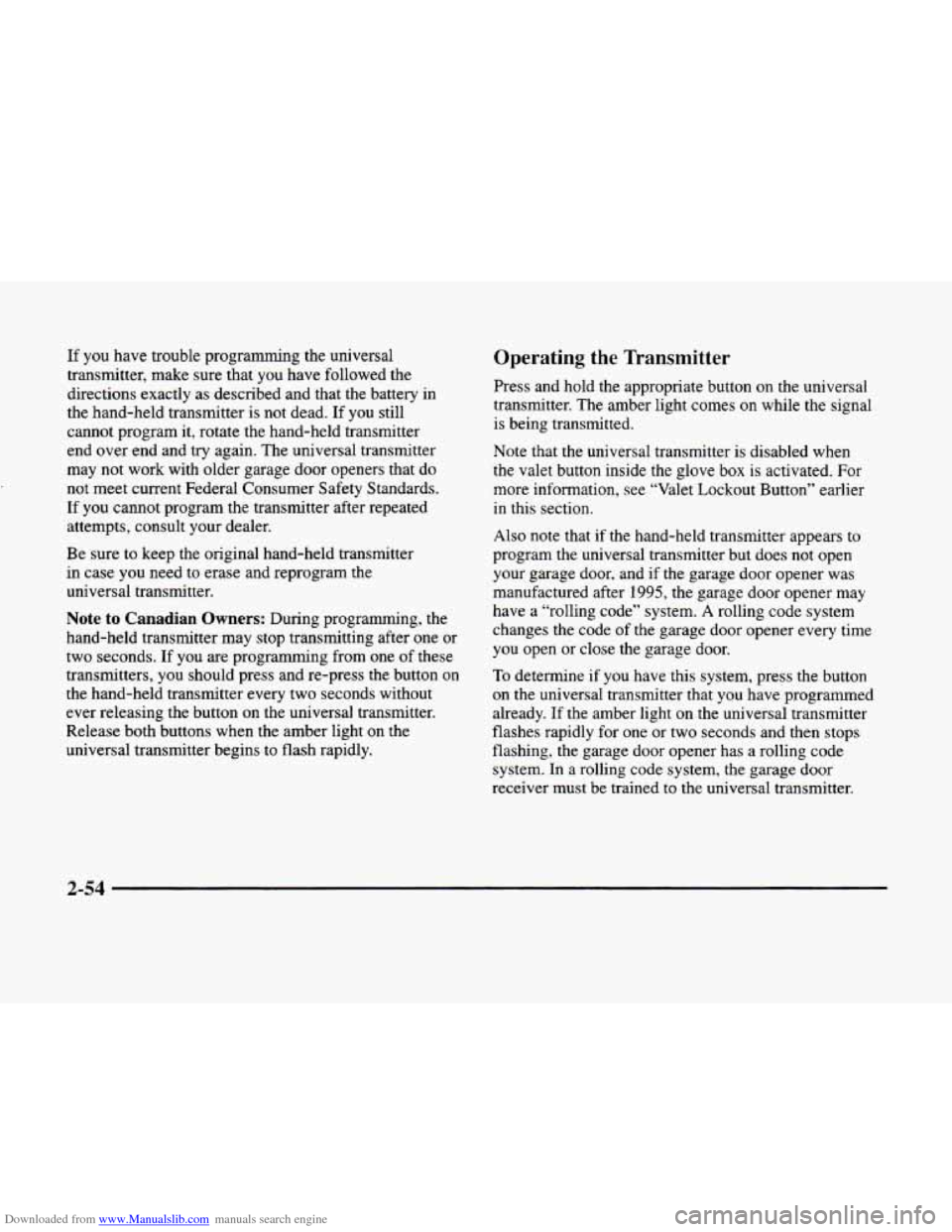
Downloaded from www.Manualslib.com manuals search engine If you have trouble programming the universal
transmitter, make sure that you have followed the
directions exactly as described and that the battery
in
the hand-held transmitter is not dead. If you still
cannot program it, rotate the hand-held transmitter
end over end and try again. The universal transmitter
may not work with older garage door openers that
do
not meet current Federal Consumer Safety Standards.
If you cannot program the transmitter after repeated
attempts, consult your dealer.
Be sure to keep the original hand-held transmitter
in case you need to erase and reprogram the
universal transmitter.
Note to Canadian Owners: During programming, the
hand-held transmitter may stop transmitting after one or
two seconds. If you are programming from one of these
transmitters, you should press and re-press the button
on
the hand-held transmitter every two seconds without
ever releasing the button
on the universal transmitter.
Release both buttons when the amber light on the
universal transmitter begins to flash rapidly.
Operating the Transmitter
Press and hold the appropriate button on the universal
transmitter. The amber light comes on while the signal
is being transmitted.
Note that the universal transmitter is disabled when
the valet button inside the glove box is activated. For
more information, see “Valet Lockout Button” earlier
in this section.
Also note that
if the hand-held transmitter appears to
program the universal transmitter but does not open
your garage door, and
if the garage door opener was
manufactured after
1995, the garage door opener may
have a “rolling code” system.
A rolling code system
changes the code of the garage door opener every time
you open or close the garage door.
To determine if you have this system, press the button
on the universal transmitter that you have programmed
already.
If the amber light on the universal transmitter
flashes rapidly for one or two seconds and then stops
flashing, the garage door opener has
a rolling code
system. In a rolling code system, the garage door
receiver must
be trained to the universal transmitter.
Page 125 of 380
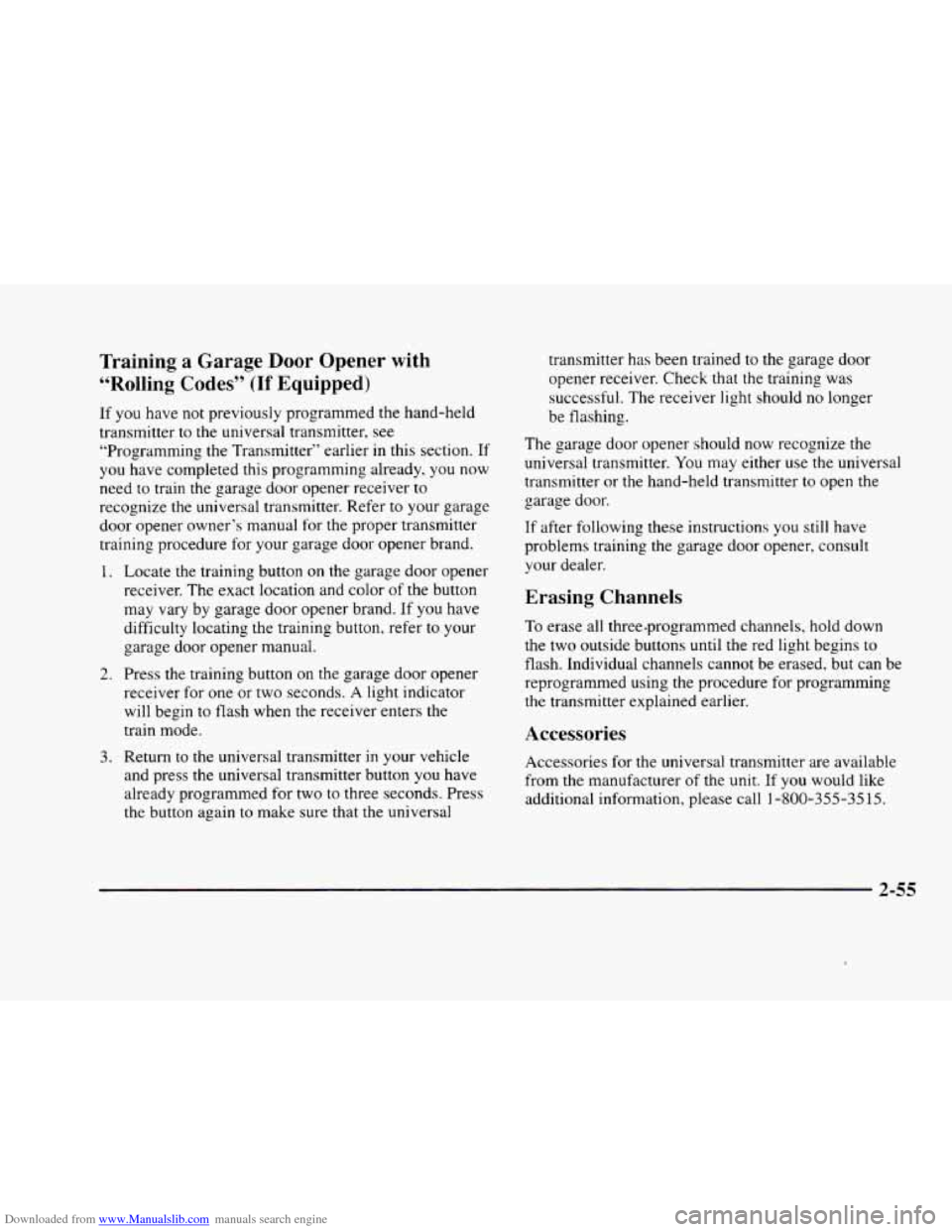
Downloaded from www.Manualslib.com manuals search engine Training a Garage Door Opener with
“Rolling Codes”
(If Equipped)
If you have not previously programmed the hand-held
transmitter to
the universal transmitter. see
“Programming the Transmitter” earlier in this section. If
you have completed this programming already. you now
need to train the garage door opener receiver
to
recognize the universal transmitter. Refer to your garage
door opener owner’s manual
for the proper transmitter
training procedure for your garage door opener brand.
1.
2.
3.
Locate the training button on the garage door opener
receiver. The exact location and color
of the button
may vary by garage door opener brand.
If you have
difficulty locating the training button. refer to your
garage door opener manual.
Press the training button on the garage door opener
receiver for one or two seconds.
A light indicator
will begin
to flash when the receiver enters the
train mode.
Return to
the universal transmitter in your vehicle
and press the universal transmitter button
you have
already programmed for two to three seconds. Press
the button again to make sure that the universal transmitter
has been trained to the garage door
opener receiver. Check that the training was
successful. The receiver light should
no longer
be flashing.
The garage door opener should now recognize the
universal transmitter. You may either use
the universal
transmitter or the hand-held transmitter to open the
garage door.
If after following these instructions you still have
problems training the garage door opener, consult
your dealer.
Erasing Channels
To erase all three-programmed channels, hold down
the two outside buttons until the red light begins to
flash. Individual channels cannot be erased, but can be
reprogrammed using the procedure for Programming
the transmitter explained earlier.
Accessories
Accessories for the universal transmitter are available
from
the manufacturer of the unit. If you would like
additional information, please call
1-800-355-35 15.
2-55
Page 131 of 380
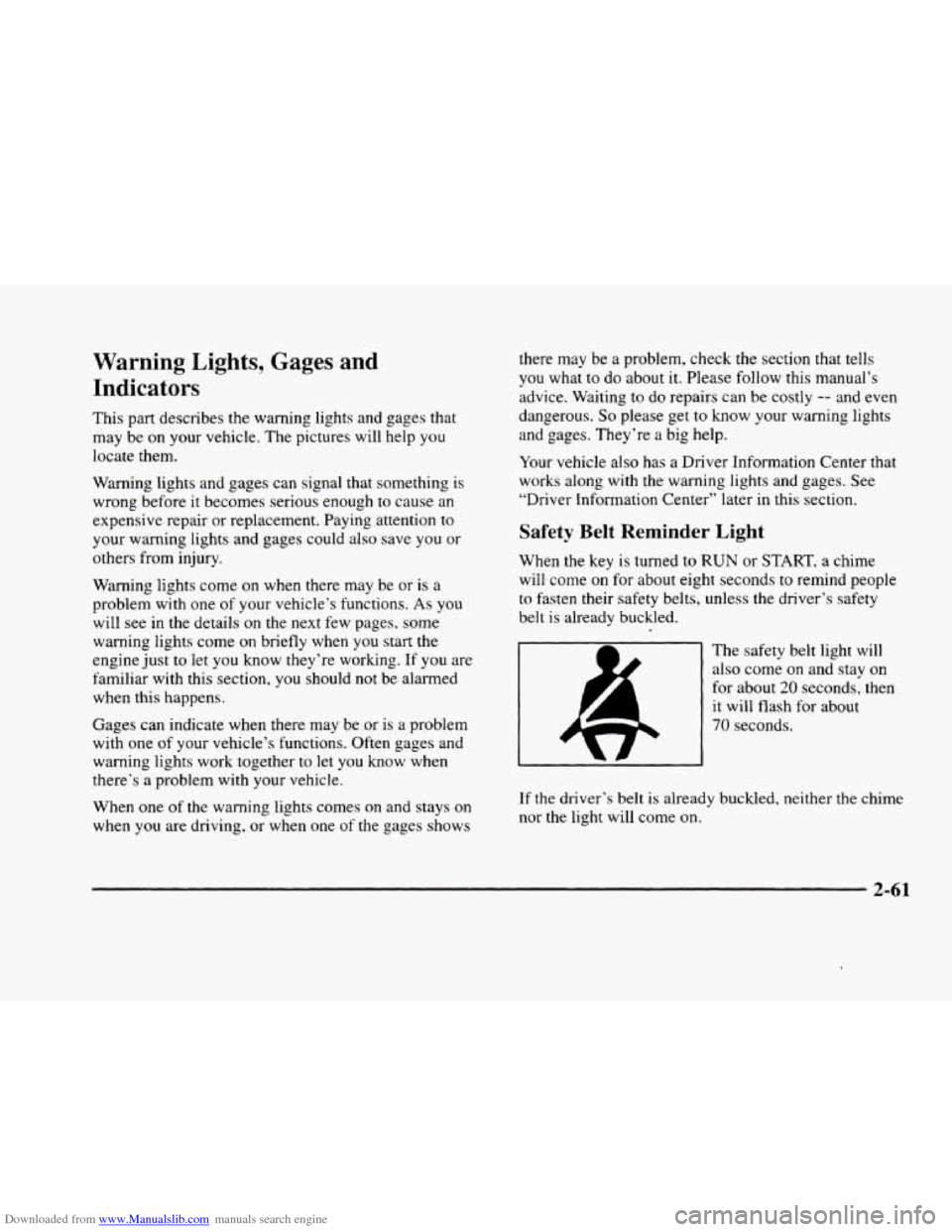
Downloaded from www.Manualslib.com manuals search engine Warning Lights, Gages and
Indicators
This part describes the warning lights and gages that
may be
on your vehicle. The pictures will help you
locate them.
Warning lights and gages can signal that something is
wrong before it becomes serious enough to cause an
expensive repair or replacement. Paying attention to
your warning lights and gages could also save you or
others
from injury.
Warning lights come
on when there may be or is a
problem with one of
your vehicle’s functions. As you
will see in the details on the next few pages,
some
warning lights come on briefly when you start the
engine
just to let you know they’re working. If you are
familiar with this section,
you should not be alarmed
when this happens.
Gages can indicate when there may be or is a problem
with one
of your vehicle’s functions. Often gages and
warning lights work together to let
you know when
there‘s
a problem with your vehicle.
When one
of the warning lights comes on and stays on
when you are driving, or when one of the gages shows there
may be a problem, check the section that tells
you what to do about it. Please follow this manual’s
advice. Waiting to do repairs can be costly
-- and even
dangerous.
So please get to know your warning lights
and gages. They’re a big help.
Your vehicle also
has a Driver Information Center that
works along with
the warning lights and gages. See
“Driver Information Center” later
in this section.
Safety Belt Reminder Light
When the key is turned to RUN or START, a chime
will come on for about eight seconds
to remind people
to fasten their safety belts, unless the driver’s safety
belt is already buckled.
The safety belt light will
also come
on and stay on
for about 20 seconds, then
it will flash for about
70 seconds.
If the driver’s belt is already buckled, neither the chime
nor the light will come
on.
2-61
Page 132 of 380
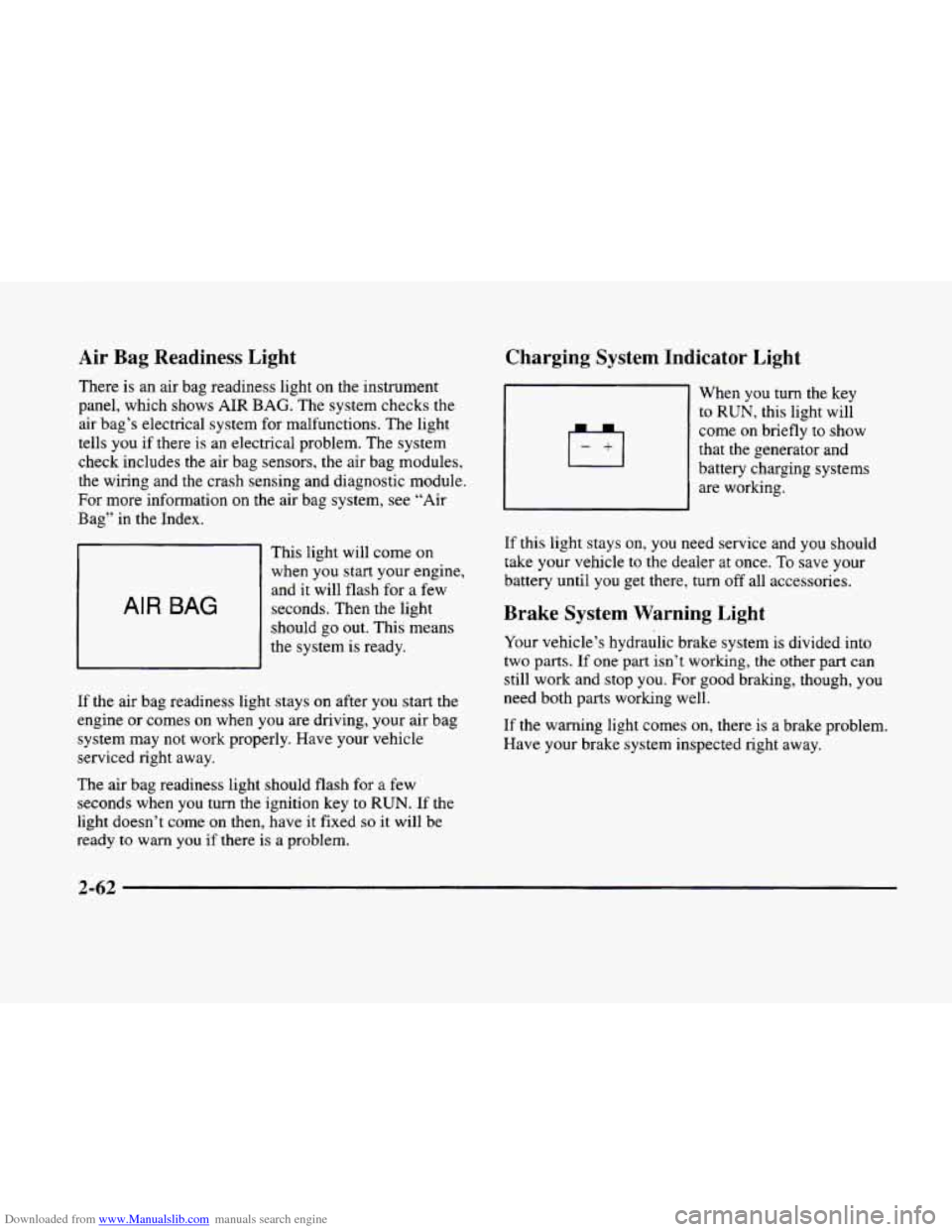
Downloaded from www.Manualslib.com manuals search engine Air Bag Readiness Light
There is an air bag readiness light on the instrument
panel, which shows
AIR BAG. The system checks the
air bag’s electrical system for malfunctions. The light
tells you if there is an electrical problem. The system
check includes the air bag sensors, the air bag modules,
the wiring and the crash sensing and diagnostic module,
For more information
on the air bag system, see “Air
Bag” in the Index.
AIR BAG
This light will come on
when you start your engine,
and it will flash for
a few
seconds. Then the light
should go out. This means
the system
is ready.
If the air bag readiness light stays on after you start the
engine or comes
on when you are driving, your air bag
system may not work properly. Have your vehicle
serviced right away.
The air bag readiness light should flash for
a few
seconds when
you turn the ignition key to RUN. If the
light doesn’t come
on then, have it fixed so it will be
ready to warn you if there is a problem.
Charging System Indicator Light
When you turn the key
to RUN, this light will
come on briefly
to show
that the generator and
battery charging systems
are working.
If this light stays on, you need service and you should
take your vehicle to the dealer at once.
To save your
battery until
you get there, turn off all accessories.
Brake System Warning Light
Your vehicle’s hydraulic brake system is divided into
two
parts. If one part isn’t working, the other part can
still work and stop
you. For good braking, though, you
need both parts working well.
If the warning light comes on, there is a brake problem.
Have your brake system inspected right away.
Page 133 of 380
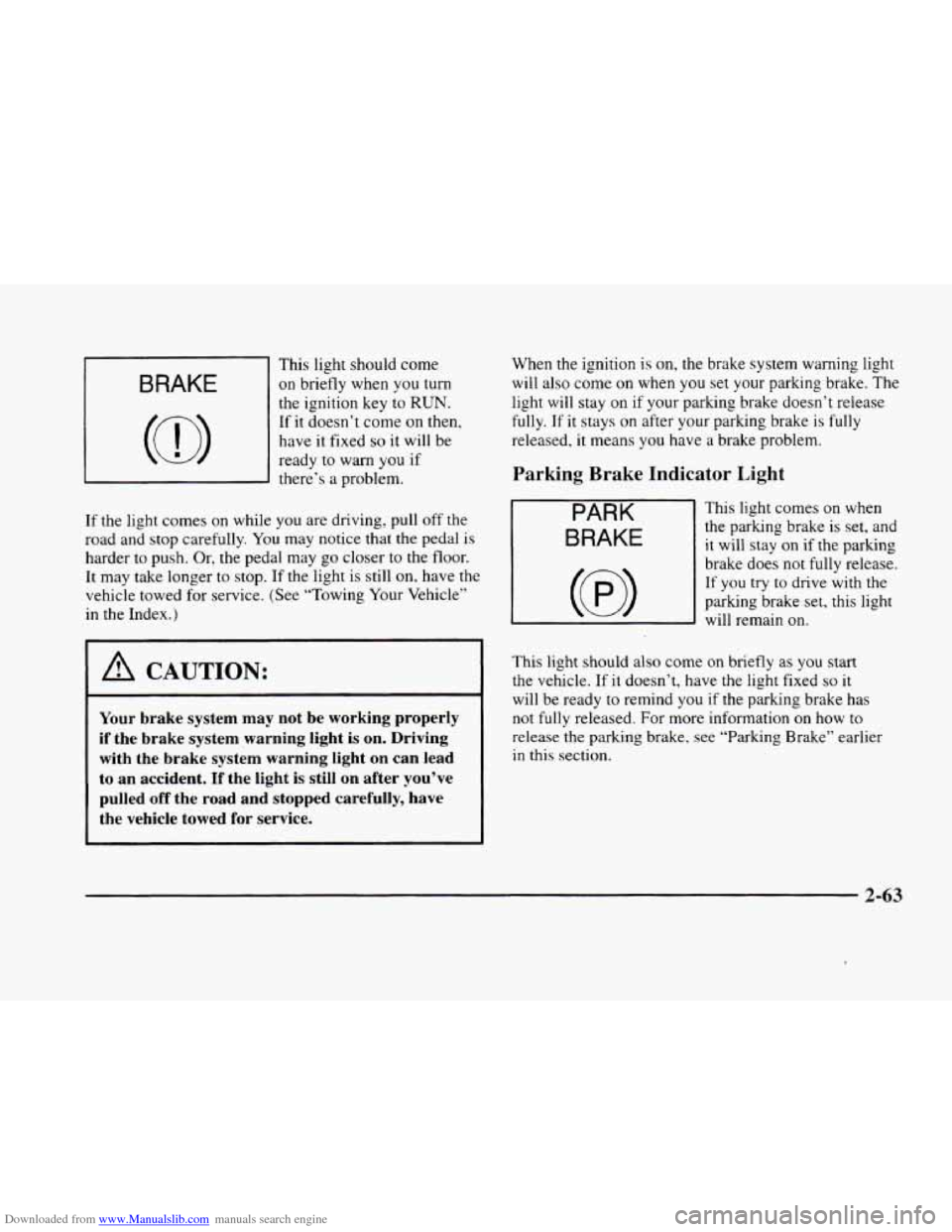
Downloaded from www.Manualslib.com manuals search engine This light should come
BRAKE I on briefly when you turn
c
~
the ignition key to RUN.
If it doesn’t come on then,
have
it fixed so it will be
ready
to warn you if
there’s a problem.
If the light comes on while you are driving, pull off the
road and stop carefully.
You may notice that the pedal is
harder to push. Or, the pedal may go closer to the floor.
It may take longer
to stop. If the light is sti1.l on, have the
vehicle towed for service. (See “Towing Your Vehicle”
in the Index.)
1 A CAUTION:
Your brake system may not be working properly
if the brake system warning light is on. Driving
with the brake system warning light
on can lead
to an accident.
If the light is still on after you’ve
pulled off the road and stopped carefully, have
the vehicle towed for service.
When the ignition is on, the brake system warning light
will also come on when you set your parking brake. The
light will stay on if your parking brake doesn’t release
fully. If it stays on after your parking brake is fully
released, it means you have a brake problem.
Parking Brake Indicator Light
PARK
BRAKE
This light comes on when
the parking brake is set, and
it will stay on if the parking
brake does not
fully release.
If you try to drive with the
parking brake set, this light
will remain
on.
This light should also come on briefly as you start
the vehicle. If it doesn’t, have the light fixed so it
will be ready to remind you if the parking brake has
not fully released. For more information
on how to
release the parking brake, see “Parking Brake” earlier
in this section.
2-63
Page 134 of 380
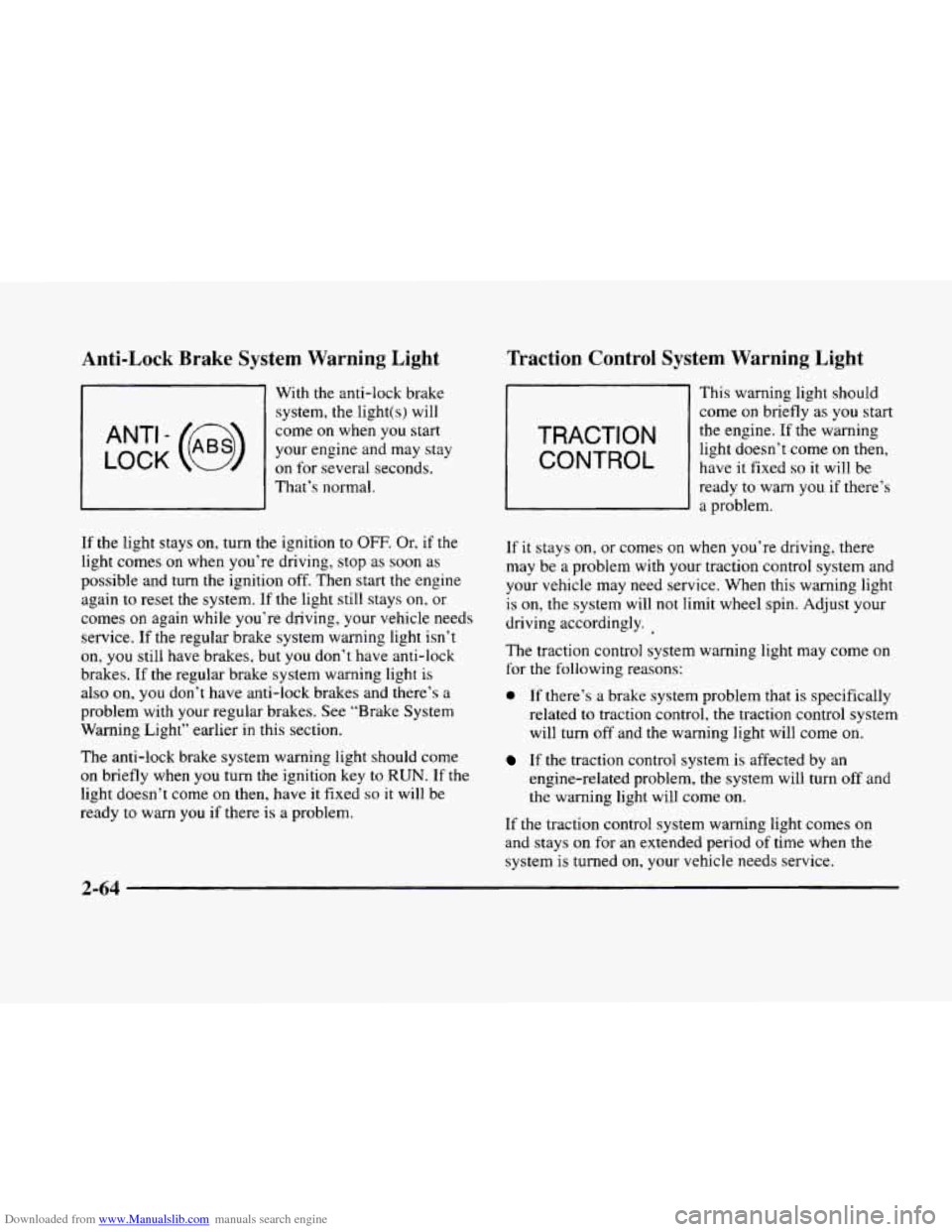
Downloaded from www.Manualslib.com manuals search engine Anti-Lock Brake System Warning Light
LOCK
ANT’- (e)
With the anti-lock brake system, the light(s) will
come on when you start
your engine and may stay
on for several seconds,
That’s normal.
If
the light stays on, turn the ignition to OFF. Or. if the
light comes on when you’re driving, stop as soon as
possible and turn the ignition off. Then start the engine
again to reset the system. If
the light still stays on, or
comes on again while you’re driving, your vehicle needs
service.
If the regular brake system warning light isn’t
on, you still have brakes, but you don’t have anti-lock
brakes. If
the regular brake system warning light is
also on, you don’t have anti-lock brakes and there’s a
problem with your regular brakes. See “Brake System
Warning Light” earlier in this section.
The anti-lock brake system warning light should come
on briefly when you turn the ignition key to RUN. If the
light doesn’t come on then, have it fixed so it will be
ready to warn you if there
is a problem.
Traction Control System Warning Light
TRACTION
CONTROL
This warning light should
come
on briefly as you start
the engine. If the warning
light doesn’t come on then,
have it fixed
so it will be
ready
to warn you if there’s
a problem.
If
it stays on, or comes on when you’re driving, there
may be
a problem with your traction control system and
your vehicle may need service. When this warning light
is on, the system will not limit wheel spin. Adjust your
driving accordingly.
The traction control system warning light may come on
for the following reasons:
0 If there’s a brake system problem that is specifically
related
to traction control, the traction control system
will turn
off and the warning light will come on.
If the traction control system is affected by an
engine-related problem, the system will turn
off and
the warning light will come on.
If the traction control system warning light comes on
and stays on for an extended period of time when the
system is turned
on, your vehicle needs service.
2-64
Page 135 of 380
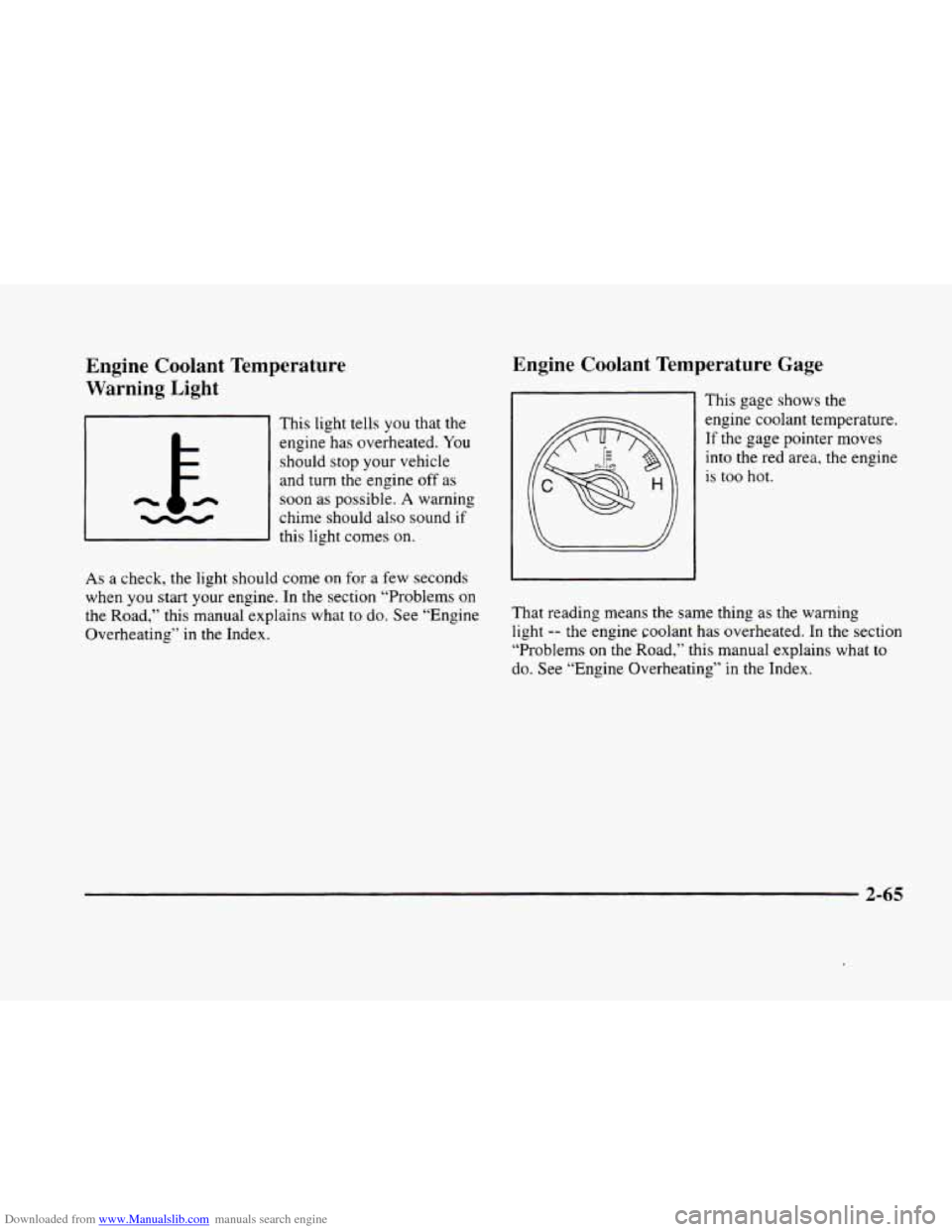
Downloaded from www.Manualslib.com manuals search engine Engine Coolant Temperature
Warning Light
This light tells you that the
engine has overheated. You
should stop your vehicle
and
turn the engine off as
n
chime should also sound if -
soon as possible. A warning
this light comes on.
As
a check, the light should come on for a few seconds
when
you start your engine. In the section “Problems on
the Road,” this manual explains what
to do. See “Engine
Overheating’‘ in the Index.
Engine Coolant Temperature Gage
This gage shows the
engine coolant temperature. If the gage pointer moves
into the
red area, the engine
is
too hot.
That reading means the same thing as the warning
light -- the engine coolant has overheated. In the section
“Problems on the Road,” this manual explains what
to
do. See “Engine Overheating” in the Index.
2-65